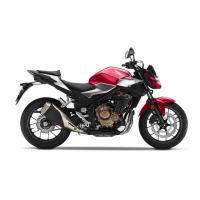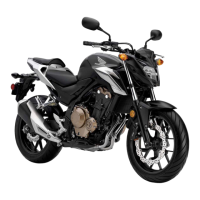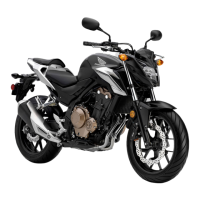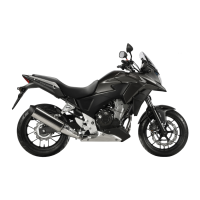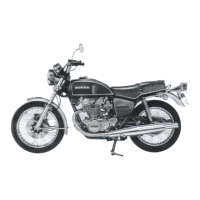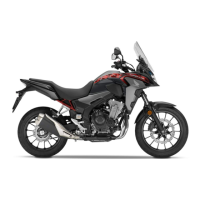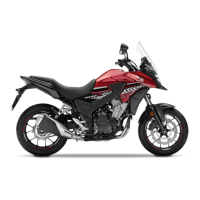Do you have a question about the Honda CB500F/FA and is the answer not in the manual?
Follow guidelines to enhance safety, including inspections, fuel handling, and engine operation.
Information and warning labels on the motorcycle provide important safety information and may warn of potential hazards.
Guidelines for safe riding, including protective apparel like helmets and gloves, and rider behavior.
Advice on break-in period, brakes, low traction surfaces, and riding within limits.
Advisories against unauthorized accessories and modifications that can affect safety and legality.
Guidelines on carrying extra weight, ensuring secure and balanced luggage, and avoiding overloading.
Diagrams illustrating the location of various motorcycle parts and components.
Explanation of the speedometer, tachometer, fuel gauge, clock, and odometer functions.
Description of dashboard indicators like oil pressure, ABS, turn signals, and PGM-FI malfunction lamp.
Details on the function and operation of the engine stop switch, start button, horn, and other controls.
Procedure for starting the engine, including pre-start checks and troubleshooting for non-starting issues.
Explanation of the 6-speed transmission and recommended shift points for smooth operation.
Instructions on opening and closing the fuel fill cap, fuel type, octane, and tank capacity.
Explains why regular maintenance is crucial for safety, performance, and longevity of the motorcycle.
Details the recommended service intervals and tasks for ensuring safe and dependable performance.
Covers pre-ride inspections, periodic checks, and basic maintenance procedures.
Diagnoses issues when the starter motor operates but the engine doesn't, or when the starter motor doesn't operate.
Addresses engine overheating symptoms, checks for radiator fan operation, and coolant leaks.
Explains symptoms and actions for the low oil pressure warning light, including checking oil level.
Details the PGM-FI warning light and actions to take if it illuminates while riding.
Describes ABS indicator behavior and troubleshooting steps for ABS system issues.
Illustrates how fuel gauge errors are displayed and advises consulting a dealer.
Provides guidance on emergency tire repair using a kit and removing/installing wheels for repair.
Covers issues like a dead battery and replacing burned-out light bulbs, including troubleshooting steps.
Details how to inspect and replace fuses in the fuse box and the main fuse.
Information on ignition keys, key tags, and procedures for obtaining duplicate keys.
Details on ignition switch, engine stop switch, odometer, tripmeter, and ignition cut-off system.
Guidelines for washing, drying, lubricating, and waxing the motorcycle to maintain its condition.
Instructions for storing the motorcycle, including washing, lubricating, battery care, and using covers.
Recommendations for safely transporting the motorcycle using trailers or trucks with tie-down straps.
Advice on protecting the environment, including using biodegradable detergents and avoiding harmful cleaners.
Explanation of VIN and engine serial number, their importance for registration and parts ordering.
Overview of exhaust, crankcase, fuel permeation, and noise emission control systems.
Details on the three-way catalytic converter's function, importance, and how to protect it.
Information on gasolines blended with alcohol or ether, their compatibility, and potential issues.
Information on obtaining service manuals, common service manuals, and winter storage guides.
Explanation of warranty coverage, limitations, and procedures for seeking service from dealers.
Contact information for American Honda Motor Co., Inc. and Honda Canada Inc. for feedback and inquiries.
Instructions on reporting vehicle safety defects to NHTSA and American Honda Motor Co., Inc.
Key physical dimensions, weight, capacity, and gear ratios of the motorcycle.
Technical specifications for tires, fluids, spark plugs, engine oil, and chain.
Details the types and specifications of bulbs used for headlights, taillights, and turn signals.
Lists the main and other fuses with their amperage ratings for the CB500F and CB500FA models.
Provides critical torque values for various fasteners and components during maintenance and assembly.
Follow guidelines to enhance safety, including inspections, fuel handling, and engine operation.
Information and warning labels on the motorcycle provide important safety information and may warn of potential hazards.
Guidelines for safe riding, including protective apparel like helmets and gloves, and rider behavior.
Advice on break-in period, brakes, low traction surfaces, and riding within limits.
Advisories against unauthorized accessories and modifications that can affect safety and legality.
Guidelines on carrying extra weight, ensuring secure and balanced luggage, and avoiding overloading.
Diagrams illustrating the location of various motorcycle parts and components.
Explanation of the speedometer, tachometer, fuel gauge, clock, and odometer functions.
Description of dashboard indicators like oil pressure, ABS, turn signals, and PGM-FI malfunction lamp.
Details on the function and operation of the engine stop switch, start button, horn, and other controls.
Procedure for starting the engine, including pre-start checks and troubleshooting for non-starting issues.
Explanation of the 6-speed transmission and recommended shift points for smooth operation.
Instructions on opening and closing the fuel fill cap, fuel type, octane, and tank capacity.
Explains why regular maintenance is crucial for safety, performance, and longevity of the motorcycle.
Details the recommended service intervals and tasks for ensuring safe and dependable performance.
Covers pre-ride inspections, periodic checks, and basic maintenance procedures.
Diagnoses issues when the starter motor operates but the engine doesn't, or when the starter motor doesn't operate.
Addresses engine overheating symptoms, checks for radiator fan operation, and coolant leaks.
Explains symptoms and actions for the low oil pressure warning light, including checking oil level.
Details the PGM-FI warning light and actions to take if it illuminates while riding.
Describes ABS indicator behavior and troubleshooting steps for ABS system issues.
Illustrates how fuel gauge errors are displayed and advises consulting a dealer.
Provides guidance on emergency tire repair using a kit and removing/installing wheels for repair.
Covers issues like a dead battery and replacing burned-out light bulbs, including troubleshooting steps.
Details how to inspect and replace fuses in the fuse box and the main fuse.
Information on ignition keys, key tags, and procedures for obtaining duplicate keys.
Details on ignition switch, engine stop switch, odometer, tripmeter, and ignition cut-off system.
Guidelines for washing, drying, lubricating, and waxing the motorcycle to maintain its condition.
Instructions for storing the motorcycle, including washing, lubricating, battery care, and using covers.
Recommendations for safely transporting the motorcycle using trailers or trucks with tie-down straps.
Advice on protecting the environment, including using biodegradable detergents and avoiding harmful cleaners.
Explanation of VIN and engine serial number, their importance for registration and parts ordering.
Overview of exhaust, crankcase, fuel permeation, and noise emission control systems.
Details on the three-way catalytic converter's function, importance, and how to protect it.
Information on gasolines blended with alcohol or ether, their compatibility, and potential issues.
Information on obtaining service manuals, common service manuals, and winter storage guides.
Explanation of warranty coverage, limitations, and procedures for seeking service from dealers.
Contact information for American Honda Motor Co., Inc. and Honda Canada Inc. for feedback and inquiries.
Instructions on reporting vehicle safety defects to NHTSA and American Honda Motor Co., Inc.
Key physical dimensions, weight, capacity, and gear ratios of the motorcycle.
Technical specifications for tires, fluids, spark plugs, engine oil, and chain.
Details the types and specifications of bulbs used for headlights, taillights, and turn signals.
Lists the main and other fuses with their amperage ratings for the CB500F and CB500FA models.
Provides critical torque values for various fasteners and components during maintenance and assembly.
| Displacement | 471cc |
|---|---|
| Compression Ratio | 10.7:1 |
| Ignition | Computer-controlled digital transistorized with electronic advance |
| Starter | Electric |
| Transmission | 6-speed |
| Final Drive | Chain |
| Engine Type | Liquid-cooled parallel-twin |
| Bore x Stroke | 67.0mm x 66.8mm |
| Fuel System | PGM-FI fuel injection |
| Front Suspension | 41 mm telescopic fork |
| Rear Suspension | Pro-Link single shock |
| Front Brakes | Single 320 mm wave disc with two-piston caliper |
| Rear Brakes | Single 240 mm wave disc with single-piston caliper |
| Front Tire | 120/70-17 |
| Rear Tire | 160/60-17 |
| Seat Height | 785 mm |
| Wheelbase | 1, 410 mm |
